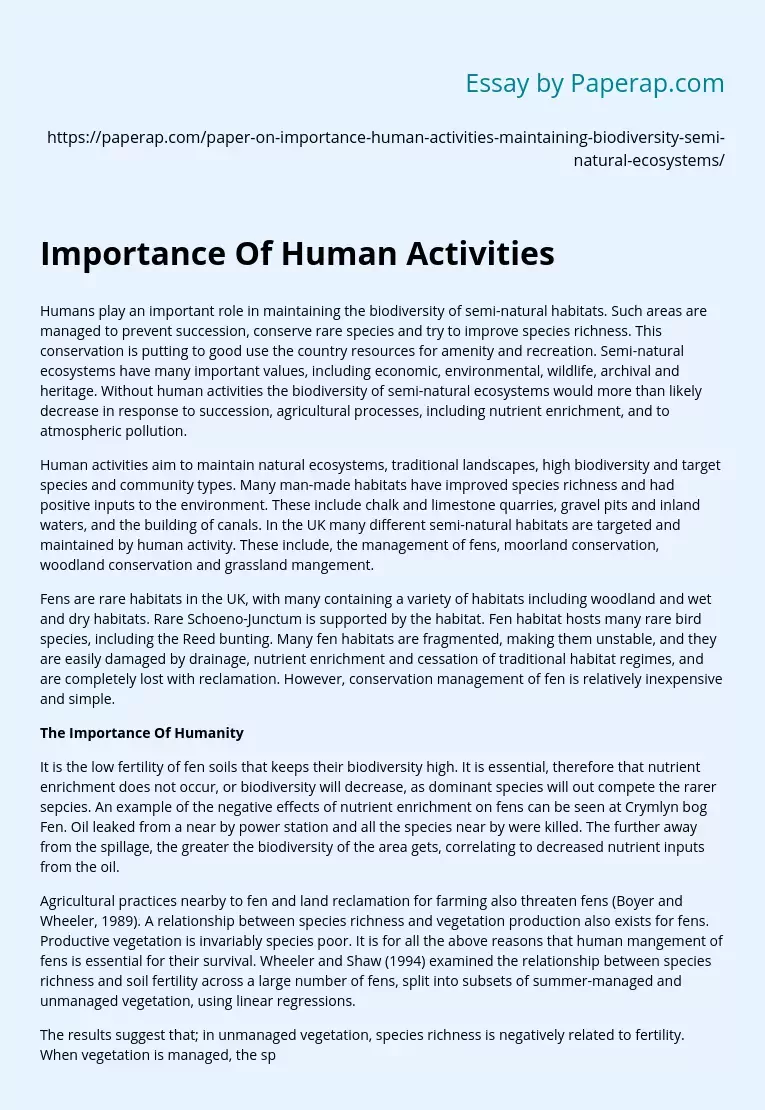Role of Human Activities in Maintaining the Biodiversity
Humans play an important role in maintaining the biodiversity of semi-natural habitats. Such areas are managed to prevent succession, conserve rare species and try to improve species richness. This conservation is putting to good use the country resources for amenity and recreation. Semi-natural ecosystems have many important values, including economic, environmental, wildlife, archival and heritage. Without human activities the biodiversity of semi-natural ecosystems would more than likely decrease in response to succession, agricultural processes, including nutrient enrichment, and to atmospheric pollution.
Human activities aim to maintain natural ecosystems, traditional landscapes, high biodiversity and target species and community types. Many man-made habitats have improved species richness and had positive inputs to the environment. These include chalk and limestone quarries, gravel pits and inland waters, and the building of canals. In the UK many different semi-natural habitats are targeted and maintained by human activity. These include, the management of fens, moorland conservation, woodland conservation and grassland mangement.
Fens are rare habitats in the UK, with many containing a variety of habitats including woodland and wet and dry habitats.
Rare Schoeno-Junctum is supported by the habitat. Fen habitat hosts many rare bird species, including the Reed bunting. Many fen habitats are fragmented, making them unstable, and they are easily damaged by drainage, nutrient enrichment and cessation of traditional habitat regimes, and are completely lost with reclamation. However, conservation management of fen is relatively inexpensive and simple.
It is the low fertility of fen soils that keeps their biodiversity high. It is essential, therefore that nutrient enrichment does not occur, or biodiversity will decrease, as dominant species will out compete the rarer sepcies.
An example of the negative effects of nutrient enrichment on fens can be seen at Crymlyn bog Fen. Oil leaked from a near by power station and all the species near by were killed. The further away from the spillage, the greater the biodiversity of the area gets, correlating to decreased nutrient inputs from the oil.
Agricultural practices nearby to fen and land reclamation for farming also threaten fens (Boyer and Wheeler, 1989). A relationship between species richness and vegetation production also exists for fens. Productive vegetation is invariably species poor. It is for all the above reasons that human mangement of fens is essential for their survival. Wheeler and Shaw (1994) examined the relationship between species richness and soil fertility across a large number of fens, split into subsets of summer-managed and unmanaged vegetation, using linear regressions.
The results suggest that; in unmanaged vegetation, species richness is negatively related to fertility. When vegetation is managed, the species-richness can be just as great in nutrient-rich sites as in nutrient-poor sites and that the number of rare fen species tends to be smaller in more fertile conditions, even when the vegetation is managed. For these reasons, management of nutrient rich systems can support high biodiversity, but few rare species and in low fertility systems, little or no management is needed to preserve high biodiversity.
However, some management is required and these human activities maintain the biodiversity of the fen. Species-richness of fen vegetation is related to above ground crop mass, which can be strongly influenced by management regimes. Summer managed fens in the UK have a greater number of rare species and overall species, than do unmanaged fens. Fens are also managed to prevent seral development into fen woodland, which hosts fewer species than fen. Once fen develops into fen woodland it cannot be converted back and therefore its succession needs to be prevented.
Fen management by human activity generally involves grazing. Thomas et al (1981) showed that in the Ouse Washes, Cambridge, increased grazing was associated with an increase in botanical diversity. There is also evidence that grazed fens can be richer in birds than ungrazed fens. Two Loch Lomondside fens in Scotland demonstrate this. Crom Mhin, consists of more plant species and hosts more bird species then Aber bogs, with less plant and bird species. The Norfolk Broadland forms the largest area of lowland fen in Britain, containing a large variety of plant species.
Parts of the broadland fens are maintained by human cropping activities in the area, for the two main crops, reed and sedge, that are both used for thatching. Reed is mown in winter, usually every year, or every second year. Reed is deciduous so harvesting removes dead material. Sedge is mown every summer, usually on a 3-5 year rotation. Harvesting removes biomass during the growing season and has a big impact on the character of vegetation. Wheeler and Giller (1982) examined the relationship between vegetation mangement and species richness and crop mass in broadland.
Role of Human Activities in Maintaining the Biodiversity. (2019, Dec 05). Retrieved from https://paperap.com/paper-on-importance-human-activities-maintaining-biodiversity-semi-natural-ecosystems/

